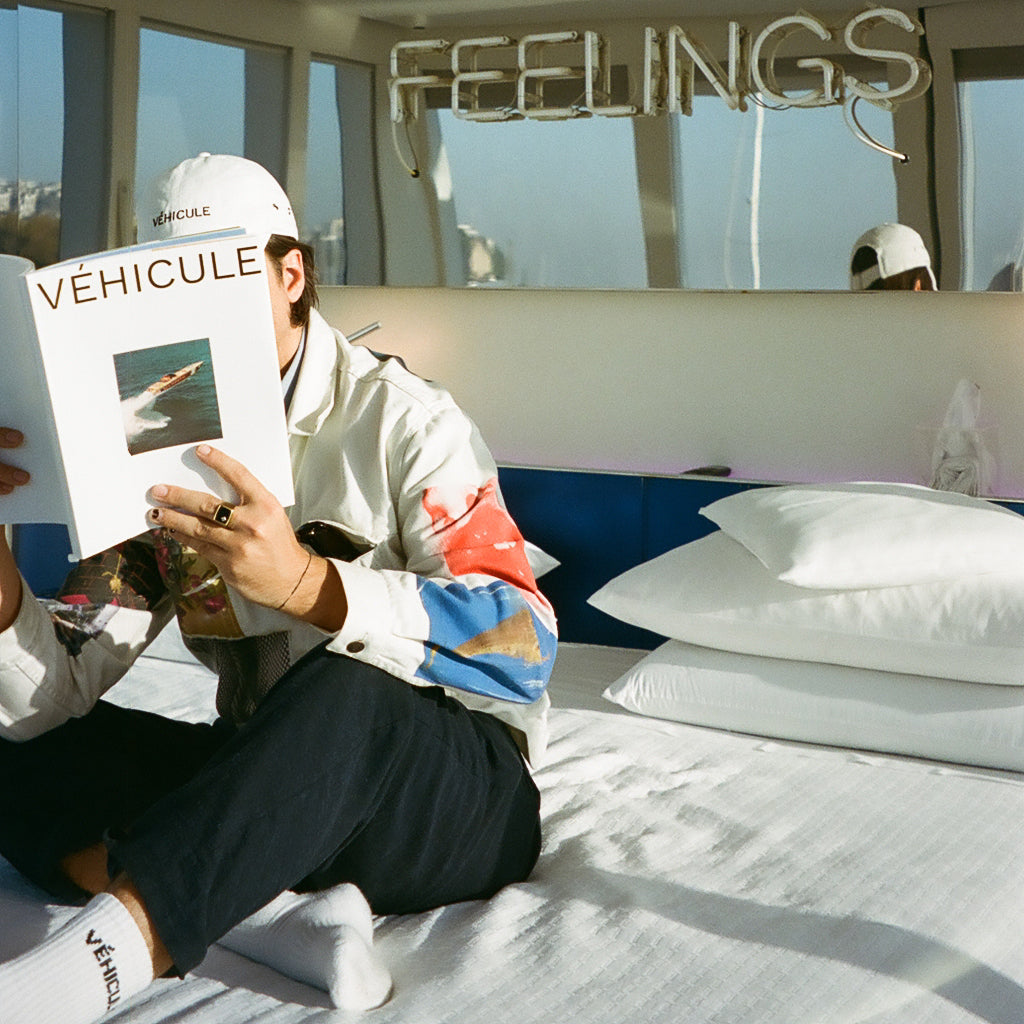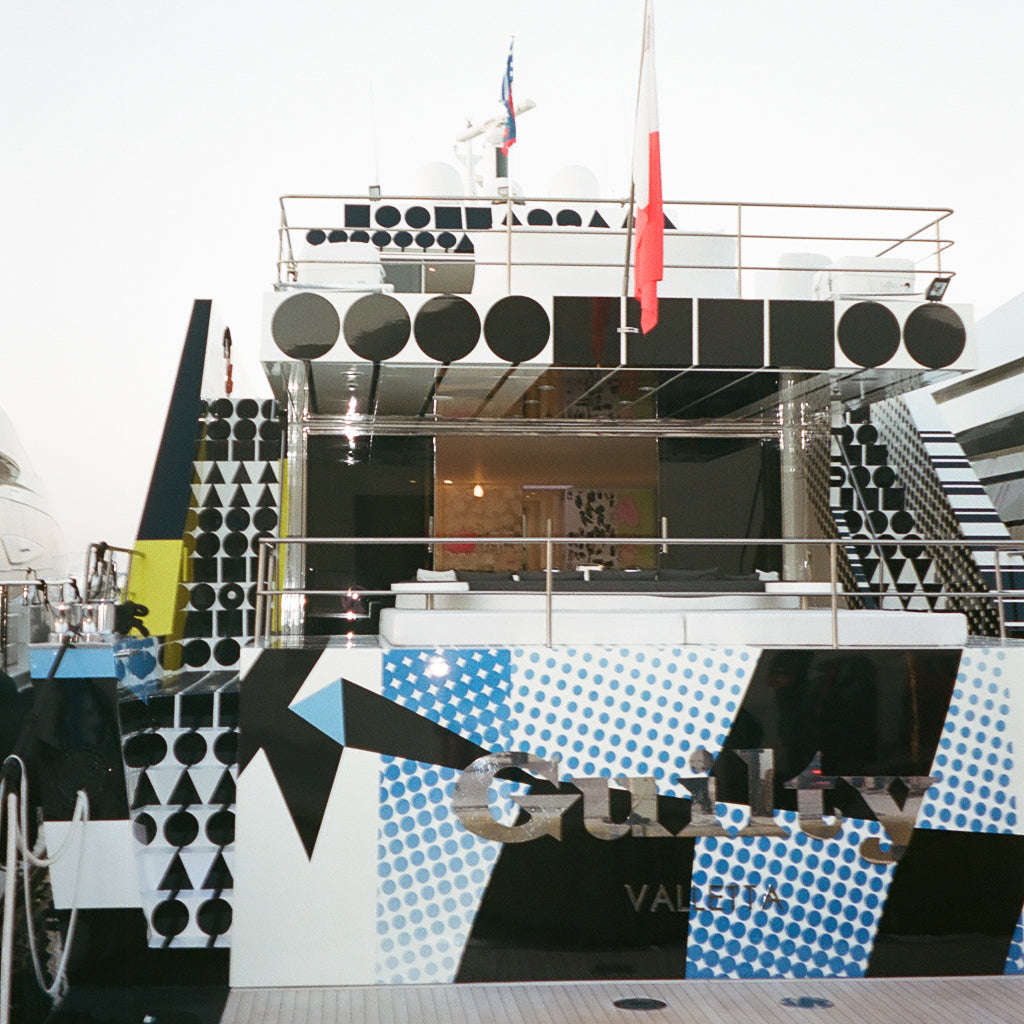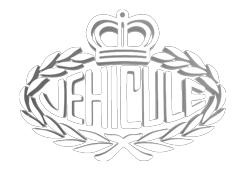Excerpt from VÉHICULE, read the whole interview here.
Dakis Joannou's mega yacht 'Guilty' by Jeff Koons and Ivana Porfiri has been called "an act of calculated irreverence"—an apt characterization to say the least.
There are no ifs, ands or buts about it—'Guilty' is a floating artwork. This isn't a mistake either. Greek-Cypriot industrialist is no stranger to the art world or its alleged excesses. In fact, as a super-collector, he's more familiar with it than you and I may ever be. And the name of his boat owns up to that fact.Docked in Athens' Piraeus Port and measuring 115 eet long, this water-bound statement of pure luxury and its Jeff Koons-designed yellow, pink and blue color scheme instantly brings to mind the bold aesthetics of 1950s Pop art or op art. In reality, 'Guilty' goes back even further. Back to World War I, in fact, and the optically mind-bending strategy of dazzle camouflage. The idea back then was to hide in plain sight. Whether this homage is really trying to hide itself is up for debate.

VÉHICULE sits down with the mastermind behind it all—yacht designer Ivana Porfiri.
VÉHICULE: How did your involvement in Guilty come about?
Porfiri: I had met Dakis Joannou, Guilty’s owner, ten years before Guilty was even conceived of or made a reality. At the time, he approached me to design the interior of his then-new yacht “Protect Me From What I Want.” Over the course of this project, we have established the special relationship that led to Guilty.
VÉHICULE: Can you talk a little bit about the creative process that you, Dakis Joannou and Jeff Koons shared?
Porfiri: This was a magical collaboration! Each of us had such an instrumental role and played off of each other so constructively. In the end, we were all tools that served a specific purpose. The owner had the role of the visionary patron, and was truly the most creative figure in the whole process. He has an amazing knack for imagination. His determination and unconventional way of thinking was at the core of Guilty. Koons and I were simply given the tools that we needed by Dakis, and we took it from there. Koons took on the task of using his talents to give color to Guilty’s exterior. His precision, perseverance and eye for perfection were key. And I was a tool for implementing everything, no matter how crazy what we came up with ended up being.
VÉHICULE: Were you happy with the outcome?
Porfiri: Working on Guilty was a huge step forward for my development as a designer, so I’m glad to have participated—happy would be an understatement.
VÉHICULE: What’s wrong with current yacht design?
Porfiri: In the early ‘90s, I started to research yacht design and gradually began to develop a new approach to the process. The yacht industry was still very conservative at the time, just repeating interior and exterior designs of the past. At the time, there was a lot of pushback to me introducing the notion of “design” as opposed to that of “style” or “decoration.” After 25 years, the scene has changed. The people who do these yachts are no longer just people who specialize in yachts and only yachts. New talent has finally made its way in, bringing experience from a number of fields, including design, with them. They’re the innovators.

The scene has changed for the better, but there’s still something going wrong. It’s rare that yacht designers take an organic approach. Too often, there is this separation between interior and exterior—it’s like they’re two separate disciplines that don’t talk to each other. That ends up being very limiting, preventing new models from taking advantage of the latest developments and entertaining new proposals or perspectives. Interior space has to influence the exterior space, and vice versa. Just acknowledging this relationship could start a new movement in the yacht industry. I keep seeing these projects in which the designer seems to be chasing an imaginary space and trying to recreate home interiors on boats. For me, a boat is a boat. We have to get back to that idea, find the origins of innovation and go from there.








